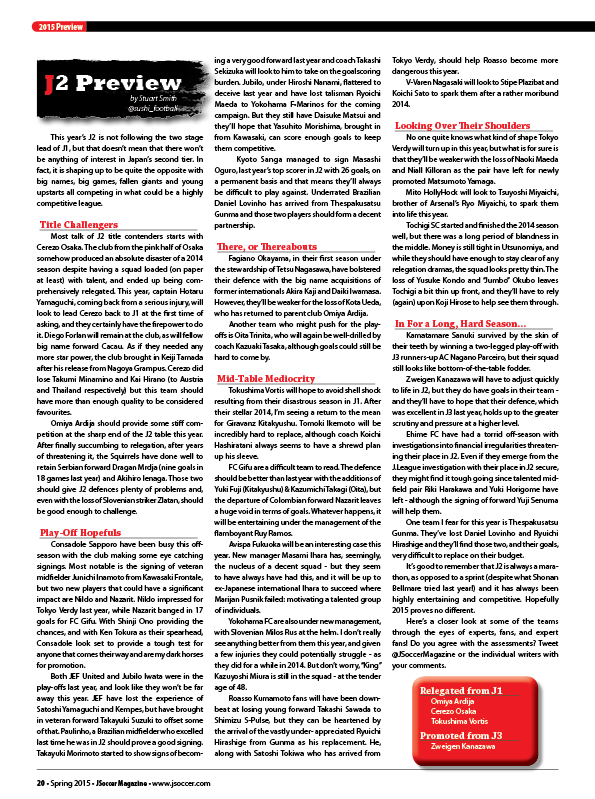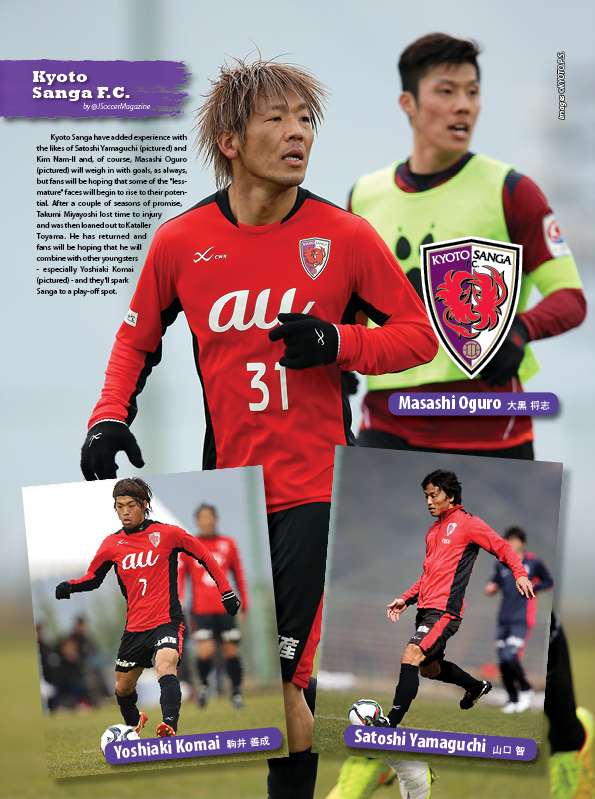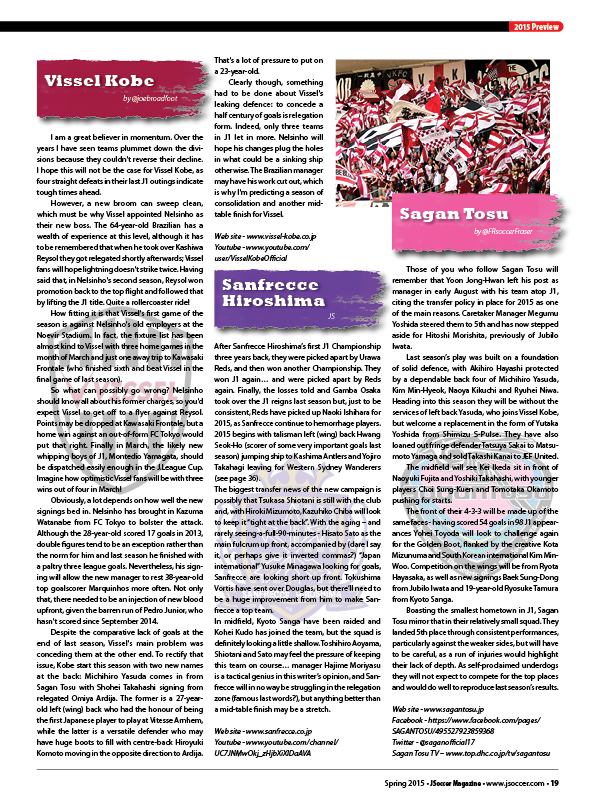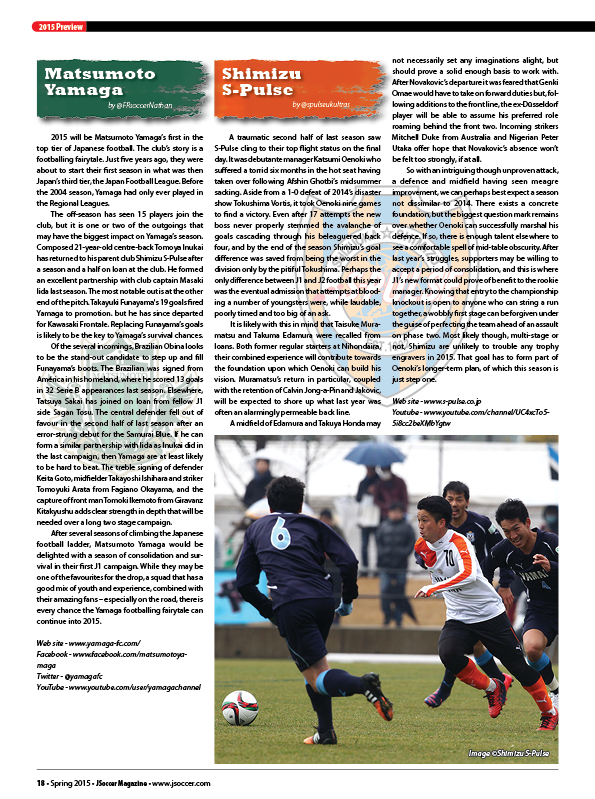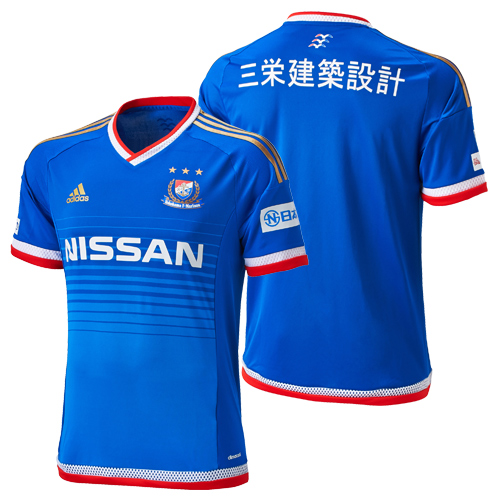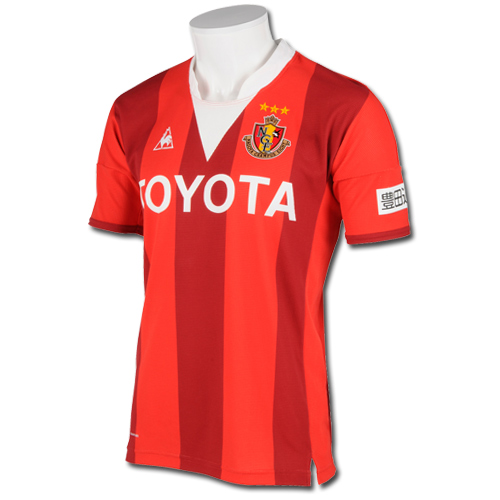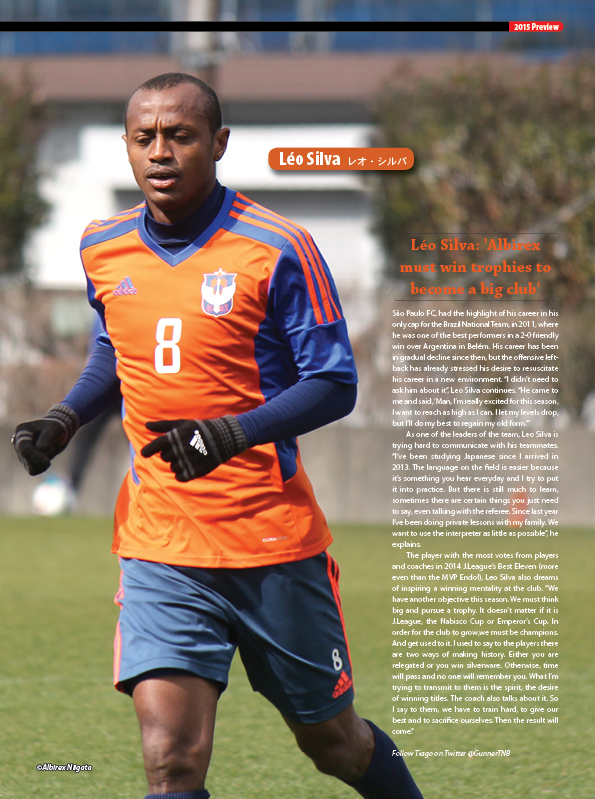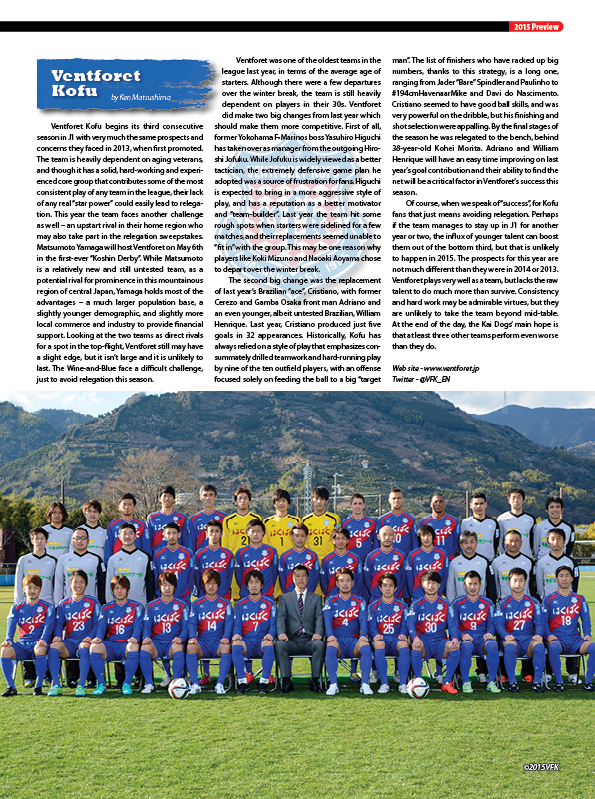Round-Up by @sushi_football
This year’s J2 is not following the two stage lead of J1, but that doesn’t mean that there won’t be anything of interest in Japan’s second tier. In fact, it is shaping up to be quite the opposite with
big names, big games, fallen giants and young upstarts all competing in what could be a highly competitive league.
Title Challengers
Most talk of J2 title contenders starts with Cerezo Osaka. The club from the pink half of Osaka somehow produced an absolute disaster of a 2014 season despite having a squad loaded (on paper at least) with talent, and ended up being comprehensively relegated. This year, captain Hotaru Yamaguchi, coming back from a serious injury, will look to lead Cerezo back to J1 at the first time of asking, and they certainly have the firepower to do it. Diego Forlan will remain at the club, as will fellow big name forward Cacau. As if they needed any more star power, the club brought in Keiji Tamada after his release from Nagoya Grampus. Cerezo did lose Takumi Minamino and Kai Hirano (to Austria and Thailand respectively) but this team should have more than enough quality to be considered favourites.
Omiya Ardija should provide some stiff competition at the sharp end of the J2 table this year. After finally succumbing to relegation, after years of threatening it, the Squirrels have done well to retain Serbian forward Dragan Mrdja (nine goals in 18 games last year) and Akihiro Ienaga. Those two should give J2 defences plenty of problems and, even with the loss of Slovenian striker Zlatan, should be good enough to challenge.
Play-Off Hopefuls
Consadole Sapporo have been busy this off -season with the club making some eye catching signings. Most notable is the signing of veteran midfielder Junichi Inamoto from Kawasaki Frontale, but two new players that could have a significant impact are Nildo and Nazarit. Nildo impressed for Tokyo Verdy last year, while Nazarit banged in 17 goals for FC Gifu. With Shinji Ono providing the chances, and with Ken Tokura as their spearhead, Consadole look set to provide a tough test for anyone that comes their way and are my dark horses for promotion.
Both JEF United and Jubilo Iwata were in the play-off s last year, and look like they won’t be far away this year. JEF have lost the experience of Satoshi Yamaguchi and Kempes, but have brought in veteran forward Takayuki Suzuki to offset some of that. Paulinho, a Brazilian midfi elder who excelled last time he was in J2 should prove a good signing. Takayuki Morimoto started to show signs of becoming a very good forward last year and coach Takashi Sekizuka will look to him to take on the goalscoring burden.
Jubilo, under Hiroshi Nanami, flattered to deceive last year and have lost talisman Ryoichi Maeda to Yokohama F•Marinos for the coming
campaign. But they still have Daisuke Matsui and they’ll hope that Yasuhito Morishima, brought in from Kawasaki, can score enough goals to keep them competitive.
Kyoto Sanga managed to sign Masashi Oguro, last year’s top scorer in J2 with 26 goals, on a permanent basis and that means they’ll always be difficult to play against. Underrated Brazilian Daniel Lovinho has arrived from Thespakusatsu Gunma and those two players should form a decent partnership.
There, or Thereabouts
Fagiano Okayama, in their first season under the stewardship of Tetsu Nagasawa, have bolstered their defence with the big name acquisitions of former internationals Akira Kaji and Daiki Iwamasa.
However, they’ll be weaker for the loss of Kota Ueda, who has returned to parent club Omiya Ardija.
Another team who might push for the playoffs is Oita Trinita, who will again be well-drilled by coach Kazuaki Tasaka, although goals could still be hard to come by.
Mid-Table Mediocrity
Tokushima Vortis will hope to avoid shell shock resulting from their disastrous season in J1.
After their stellar 2014, I’m seeing a return to the mean for Giravanz Kitakyushu. Tomoki Ikemoto will be incredibly hard to replace, although coach Koichi Hashiratani always seems to have a shrewd plan up his sleeve.
FC Gifu are a difficult team to read. The defence should be better than last year with the additions of Yuki Fuji (Kitakyushu) & Kazumichi Takagi (Oita), but the departure of Colombian forward Nazarit leaves a huge void in terms of goals. Whatever happens, it will be entertaining under the management of the flamboyant Ruy Ramos.
Avispa Fukuoka will be an interesting case this year. New manager Masami Ihara has, seemingly, the nucleus of a decent squad – but they seem to have always have had this, and it will be up to
ex-Japanese international Ihara to succeed where Marijan Pusnik failed: motivating a talented group of individuals.
Yokohama FC are also under new management, with Slovenian Milos Rus at the helm. I don’t really see anything better from them this year, and given a few injuries they could potentially struggle – as they did for a while in 2014. But don’t worry, “King” Kazuyoshi Miura is still in the squad – at the tender
age of 48.
Roasso Kumamoto fans will have been downbeat at losing young forward Takashi Sawada to Shimizu S-Pulse, but they can be heartened by the arrival of the vastly under-appreciated Ryuichi
Hirashige from Gunma as his replacement. He, along with Satoshi Tokiwa who has arrived from Tokyo Verdy, should help Roasso become more dangerous this year.
V-Varen Nagasaki will look to Stipe Plazibat and Koichi Sato to spark them after a rather moribund 2014.
Looking Over Their Shoulders
No one quite knows what kind of shape Tokyo Verdy will turn up in this year, but what is for sure is that they’ll be weaker with the loss of Naoki Maeda and Niall Killoran as the pair have left for newly promoted Matsumoto Yamaga.
Mito HollyHock will look to Tsuyoshi Miyaichi, brother of Arsenal’s Ryo Miyaichi, to spark them into life this year.
Tochigi SC started and finished the 2014 season well, but there was a long period of blandness in the middle. Money is still tight in Utsunomiya, and while they should have enough to stay clear of any relegation dramas, the squad looks pretty thin. The
loss of Yusuke Kondo and “Jumbo” Okubo leaves Tochigi a bit thin up front, and they’ll have to rely (again) upon Koji Hirose to help see them through.
In For a Long, Hard Season…
Kamatamare Sanuki survived by the skin of their teeth by winning a two-legged play-off with J3 runners-up AC Nagano Parceiro, but their squad still looks like bottom-of-the-table fodder.
Zweigen Kanazawa will have to adjust quickly to life in J2, but they do have goals in their team – and they’ll have to hope that their defence, which was excellent in J3 last year, holds up to the greater scrutiny and pressure at a higher level.
Ehime FC have had a torrid off-season with investigations into financial irregularities threatening their place in J2. They might find it tough going since talented midfield pair Riki Harakawa and Yuki Horigome have left – although the signing of forward Yuji Senuma will help them.
One team I fear for this year is Thespakusatsu Gunma. They’ve lost Daniel Lovinho and Ryuichi Hirashige and they’ll find those two, and their goals, very difficult to replace on their budget.
It’s good to remember that J2 is always a marathon, as opposed to a sprint (despite what Shonan Bellmare tried last year!) and it has always been highly entertaining and competitive. Hopefully
2015 proves no different.
Here’s a closer look at some of the teams through the eyes of experts, fans, and expert fans! Do you agree with the assessments? Tweet @JSoccerMagazine or the individual writers with your comments.
Consadole Sapporo
by @PedroIriondo
Since 2012 relegation Consadole Sapporo has always been considered a serious contender for promotion, if not directly, at least via play-offs. However the most northern J.League club has not recently been able to live up to these expectations. Last season, Consadole’s performance was once again irregular and in the first half of the season, after a series of draws and defeats, the team found themselves in the middle of the table. At this point, the club decided to replace Keichi Zaizen with Croatian manager Ivica Barbaric (ex-Ehime FC). Barbaric, who will stay on the staff for the upcoming season, managed to improve Consadole’s performance but still not enough to reach a play-off position.
The main problem in 2014 was that Consadole failed to make Sapporo Dome a fortress, winning only nine out of 21 home games, not scoring enough goals in the process. Missing Uchimura’s goals (only three scored in 2014) the attack lacked bite and it was already late in the season when Ken Tokura (eight goals) found his rhythm. Tokura’s beautiful goal (J2 goal of the season) against Shonan Bellmare may remain as the most remarkable moment of the season for Consadole’s fans.
In 2015, he will have the added pressure of wearing Consadole`s number 9 shirt. Still, with J1 as a target, the club has made a decent job of strengthening the squad. The versatile Junichi Inamoto will join Shinji Ono in Sapporo’s midfield (although Ono has garnered an injury just as the season is about to begin), and, to reinforce the front line, Consadole has also signed Colombian striker Cristian Nazarit and Indonesian international Irfan Bachdim.While the former had a decent 2014 campaign with Gifu (10 goals), the latter still needs to demonstrate his skills in Japan. Consadole may, though, struggle to cover the gap left by centreback Tatsuki Nara’s move to FC Tokyo.
Due to recent disappointments, it is difficult to know what to expect from Consadole for the coming season. The target of promotion is a must but it will be harder than ever with the addition of Cerezo Osaka and Omiya Ardija to the existing
competition. Without a big improvement Consadole may well be condemned to a mid-table finish but if the experienced players like Ono and Inamoto manage to gel with key men such as Nazarit or
Tokura, anything is possible.
Hokkaido misses J1 and the team has a debt to its fans.
JEF United
by @J2KantoBites
As usual, JEF go into a new season hoping to cast aside last year’s disappointments, and finally achieve the goal of promotion back to J1. After joining the team midway through 2014 following Jun Suzuki’s sacking, current boss Takashi Sekizuka has retooled his squad during the close season. In a much-needed change, the team has a more youthful look, especially in defence. Old-timers Satoshi
Yamaguchi and Akira Takeuchi have left, and several youngsters have been promoted from JEF’s junior ranks.There have also been some eye-catching moves in midfield, where veterans Akihiro Hyodo
and Kei Yamaguchi have been shipped out. Incoming are Brazilian midfielder Paulinho, formerly of Tochigi SC and Kawasaki Frontale, and club legend Koki Mizuno, who famously left JEF to join Celtic in
2008. This season should also see some of the club’s highly-rated young midfielders, particularly Yamato Machida and Haruya Ide, step up to become regular starters. There is an interesting blend of youth and experience in the centre of the pitch for JEF in 2015, which should make the team fascinating to watch.
Two of the more surprising departures are in the forward positions. After 38 goals in two seasons at Fukuda Denshi Arena, Brazilian target man Kempes has moved on. Furthermore, one of his regular understudies, Shohei Otsuka, has joined J2 rivals Giravanz Kitakyushu. Incoming is Slovenian striker Nejc Pecnik, a somewhat nomadic player who counts Sparta Prague, Krylia Sovetov, Sheffield Wednesday and Red Star Belgrade among his former clubs. It will be fascinating to see how Pecnik adapts to live in the Japanese second tier, and whether he can take game time away from Takayuki Morimoto and Ado Onaiwu.
JEF finished third last season, but they were a full 15 points adrift of the top two. Fans will expect, and demand, improvement this year.
Tokyo Verdy
by @Verdy_eng
With all the reported problems behind the scenes and the team struggling on the pitch, there’s nothing new in Tokyo Verdy’s world at the moment, The team finished 20th in J2 last season, but I am hoping for a mid-table finish in the coming campaign.
That would be considered a good season in my view.
Verdy start the 2015 J2 season against relegated Cerezo Osaka at Ajinomoto Stadium on the 8th March, and it will be very interesting to see how they show against the obvious J2 favourites.
The club has made a few signings over the close season. Players like Alan Pinheiro – on loan from Esporte Clube Vitória (Brazil – Campeonato Baiano Serie B) – Bruno (from SZ FC, China), Weslley
(from SC Sagamihara), Abuda (from Operário Ferroviário Esporte Clube – Campeonato Paranaense in Brazil), as well as promoting two players from the youth system – Masaomi Nakano and Kento Misao.
Verdy have also signed Ko Kyung-Joon from South China AA in Hong Kong and he will be wearing shirt number 37. I wish all the very best to the players who have left Tokyo Verdy and wish them all the success in the world, while hoping that manager Koichi Togashi and this season’s squad will make 2015 way better then 2014 ever was! Let’s hope that the Verdy fans will support the
team no matter what happens in 2015!
Avispa Fukuoka
by @perogies_gyoza
Avispa Fukuoka, who finished 16th in J2 last season, are going back to the past in their quest for promotion. Their midfield duo of Jun Suzuki and Tetsuya Sueyoshi will be reunited. Suzuki has
played a few games for Tokyo Verdy but Sueyoshi has warmed the bench for Sagan Tosu, Avispa’s biggest rival, since he left. The two were last paired in 2012, and both are local boys. Welcome home!
One returnee who does look like an improvement in the squad is full back Hokuto Nakamura. A Nagasaki native who has been playing for FC Tokyo and Omiya Ardija, a lot of hopes are pinned on Nakamura as he returns to J2. He was one of the reasons Avispa won promotion in the 2006 season and may well be able to provide leadership in another promotion run, if he can remain off the injured list.
There are two new players who are generating a lot of excitement in the pre-season. Mizuki Hamada from Urawa looks like a centre-back who can run, which Avispa has been lacking. Forward
Takayuki Nakahara has come from Vegalta Sendai, which hopefully means more goals for Avispa, as he pushes the remaining forwards, including Noriyoshi Sakai – Gotoku’s younger brother – and fan favourite Hisashi Jogo, to do more to earn the forward position.
The biggest gamble taken by Avispa this year is appointing former Japan National Team member Masami Ihara as manager. This is Ihara’s first management position although he has coached in J1 at
Kashiwa Reysol. Does he have what it takes to deal with Avispa’s continual issues and will he have the support of the organization? We can only hope.
Avispa’s main problems in recent years have been twofold – one is that they were hemorrhaging cash after their disastrous return to J1 in 2011 when they dumped almost all the players that actually
got them to J1. A new financial backer and a large infusion of cash seems to have helped with this as they aren’t threatened with losing their J1 license as in previous years, and they have been able to bring in a couple of new “J1” players.
The second issue is that the players seemed as if they had stopped
caring about halfway through last season. Last June it looked like they could go straight to the play-offs as keeper Ryuichi Kamiyama, the best keeper in J2 for the second season in a row, kept a clean sheet for the whole month. But when summer was over it seemed Avispa were done as well. This happened in previous years but we could chalk that up to players wondering if they would get paid for the last few months of the season after Avispa ran out of cash in the autumn, but in 2014 they were financially
solvent so the lack of passion for playing was all internal. Will Ihara be able to keep the team’s will alive all season long?
The return of forward Daisuke Sakata and U-21 National Team member Takeshi Kanamori, along with shot stopper extraordinaire Kamiyama give me hope for 2015. Along with the new players they should be able to build a strong defence and an aggressive front line. But with the same old issue in midfield I am not sure how far they will go.
The team’s goal for this year is a return to J1, but I think that is a few years off. I would settle for a run in the play-offs, but I think a more realistic finish is 10th place.
Yokohama FC
by @J2KantoBites
It has been a relatively low-key winter break at Mitsuzawa. By far the biggest change has been the departure of manager Motohiro Yamaguchi, who was removed despite leading the team on a fourteen-match unbeaten run in the middle of the 2014 season. However, Yokohama frequency lacked pace and dynamism outside of this impressive unbeaten streak. The man charged with rejuvenating the side is slightly-obscure Slovenian Milos Rus. The 52-year-old has spent his entire managerial career in Europe, bar one season on the coaching staff at Brummel Sendai (the JFL precursor to Vegalta) in 1997. Yokohama’s hopes of a successful campaign could hinge on how quickly Rus can get to grips with his new challenge in J2.
A lack of goals will be one potential issue for the new coach to address, with only four recognised strikers in the squad for 2015. In the current climate, Yokohama’s key player may prove to be Tetsuya ‘Jumbo’ Okubo. After falling out with Yamaguchi in 2013, Okubo spent last season in exile at J2 rivals Tochigi SC, but starts the new campaign with a clean slate. Supporters will be hoping that Okubo can replicate, and improve upon, his performances at Mitsuzawa in 2012 and 2013, where he scored 24 goals in 69 appearances.
Elsewhere, Brazilian defender Douglas has moved on. He was a first-team regular in 2014, so it remains to be seen who takes his place under the new regime. Park Tae-Hong, who has returned to
Japan after a year at Yokohama FC’s satellite team in Hong Kong, seems a likely candidate. In midfield, the squad is bolstered by the returns of Masaaki Ideguchi and Takahiro Nakazato.
After missing out on the play-offs by nine points last season, Rus will be aiming to lead the team to a top-six finish this term.
